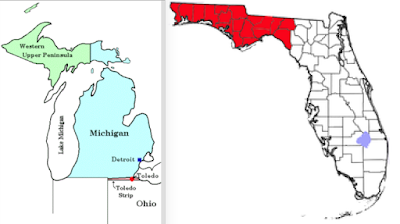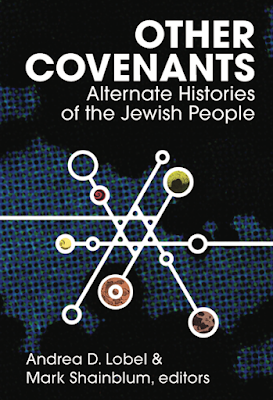A Geographical Counterfactual: Did Michigan's and Florida’s Borders Help Trump Defeat Clinton?
Yesterday’s New York Times
ran an interesting article
by Nate Cohn that nicely shows how counterfactual sheds light on the forces of historical causation.
The article seeks to determine which factors were crucial for explaining
the gap between Hillary Clinton’s and Donald Trump’s diverging performances in
the Electoral College and popular vote in the 2016 presidential election.
After discussing several factors, Cohn ends up advancing a
simple answer for Trump’s victory: “The Electoral College’s (largely)
winner-take-all design gives a lot of weight to battleground states. Mr. Trump
had an advantage in the traditional battlegrounds because most are whiter and
less educated than the country as a whole.”
Notably, Cohn partly arrives at this conclusion through counterfactual reasoning, asserting that the role of
battleground states was partly about the rule of chance – or what he calls “the
quirks of history.”
In order to support this
point, Cohn first dispenses with the claim that Trump's victory was the result
of “small state bias.”
“The Electoral College
isn’t just a check against regionalism. It also reflects our federal system by
awarding an electoral vote for every senator and representative. The result is
that small states get more sway, since senators aren’t awarded by population.”
“Wyoming, the least
populous state, has one-sixty-sixth of California’s population. Yet it has
one-eighteenth of California’s electoral votes.”
“In general, the
Electoral College’s small-state bias does hurt the Democrats. In fact, the
small-state bias tipped the 2000 election. Al Gore would have won the
presidency, 225 to 211, if electors were just awarded by representative, not by
senators and representatives.”
“But the small-state bias
was almost entirely irrelevant to Mr. Trump’s advantage. Mrs. Clinton won
plenty of small states — she won seven of the 12 smallest. Mr. Trump,
meanwhile, won plenty of big states — in fact, he won seven of the 10 largest.”
“As a consequence, the result would have been
virtually identical if states had not received electoral votes for their
senators. It would have even been the same if the electors had been apportioned
exactly by a state’s population.”
Cohn then proceeds to the heart of his
argument; Trump’s victory can be attributed to “the Electoral College’s most
straightforward bias: The battleground states count the most.”
“Mrs. Clinton did well in noncompetitive states
and “wasted” popular votes that didn’t earn her any more electoral votes, while
Mr. Trump did just well enough in competitive states to pick up their electoral
votes….”
“Mr. Trump won a lopsided electoral vote tally
from those states by narrowly winning four of the five states decided by around
one point or less: Florida, Wisconsin, Michigan and Pennsylvania (Mrs. Clinton
edged him out in New Hampshire). Outside of those five states, the electoral
vote was basically tied, with Mr. Trump edging out Mrs. Clinton, 231 to 228
(and leading by the margin of small-state bias)….”
“….The “solid red” and “solid blue” states
where Mr. Trump failed to make gains include a clear majority of the country’s
Electoral College votes, population and actual votes. The regional anomaly was
the Midwest, and it just so happens that in a winner-take-all system Mr.
Trump’s strength in the Midwestern battleground states yielded a lot of
Electoral College votes….
“But the demographics
alone don’t quite do justice to Mr. Trump’s victory in the Electoral College.
In the end, he won the battleground states by just a one-point margin — but
claimed three-fourths of their Electoral College votes.
He won four of the five
closest states, winning 75 of 79 votes at stake….”
Then Cohn comes to the
most counterfactual part of his essay when he stresses the issue of
contingency.
Asserting that “Mr. Trump had some very good
luck,” Cohn proceeds to show that Trump’s defeat of Clinton in the battleground
states was hardly preordained and adds that
“There’s nothing about
the distribution of Mrs. Clinton’s votes in the battlegrounds or nationally
that meant she was destined to get as few electoral votes as she did.
Just take Minnesota,
Wisconsin and Michigan — three contiguous states spanning the Upper Great
Lakes. Mrs. Clinton actually won the region by a narrow margin, but she won
just 10 of the 36 votes at stake….”
“Ultimately, state lines
are pretty arbitrary. Yes, when those lines were determined, there were
reasoned considerations like population and access to rivers and resources. But
statehood and state lines, often poorly surveyed in the first place, were hotly
disputed in the 19th century. Many states were created in response to political
considerations, especially the balance between free and slave states. In other
times, it could have gone very differently.”
“Consider two of the
bigger nonpolitical state boundary questions of the 19th century: the fate of
the Florida Panhandle and the “Toledo War.”
“The Toledo War was a
long dispute between Michigan and Ohio over a tiny strip of land along their
border, which happens to include the city of Toledo. Ohio had the upper hand
for one reason: It earned its statehood first, and therefore blocked Michigan’s
petition — which included the strip. In the end, Congress proposed a deal:
Michigan would relinquish its claim on the Toledo strip and, in exchange, would
get the Upper Peninsula.”
“The Florida Panhandle
and the Florida Peninsula were governed as separate regions — West and East
Florida — under Spanish and British rule. They were effectively separated by
hundreds of miles of treacherous swamp and forest”
“Ultimately, West and
East Florida were combined into one state. This was mainly coincidental:
Alabama earned statehood before the Florida territory was annexed. West Florida
repeatedly tried to join Alabama, starting as soon as the state was annexed and
lasting all the way past the Civil War. Many of these efforts — which included
referendums, congressional petitions and direct negotiations between Florida
and Alabama — nearly succeeded. But they ultimately did not.”
“If these minor border issues had gone differently, Mrs. Clinton
would probably be president. The Florida Panhandle is heavily Republican:
Without it, the rest of Florida votes Democratic. Both halves of the Toledo War
worked out poorly for Mrs. Clinton. Not only would she have won Michigan with
Toledo, but she would have also won Michigan without the Upper Peninsula: Only
the full trade gives Mr. Trump a narrow win.”
“Interestingly, the same changes would have flipped the 2000
election, and perhaps the 1876 election, to the same result as the national
popular vote (though I don’t have county-level results for Florida in that
election). The pronounced regionalism at play in 1888 would have made it harder
to change the outcome by tweaking state lines.”
“To be clear, you can
also make plenty of changes that would benefit Republicans. You could reunify
West Virginia and Virginia, to take an easy one.
The point is that the
main bias of the Electoral College isn’t against big states or regionalism;
it’s just toward the big battleground states. If they break overwhelmingly one
way, that’s who wins. This is not exactly a high-minded Hamiltonian argument.
There aren’t many justifications for letting a few close states decide a close
national election. But that’s basically what the system does, and there’s
nothing about those states that ensures they provide a representative outcome.”
These observations veer
into the category of “Cleopatra’s Nose” counterfactuals, insofar as they imply
that ostensibly minor factors can lead to major outcomes. They are also excellent examples of a “geographical” counterfactual that emphasizes
the causal power of physical space. (I posted a comment a while back on the excellent book and TV series, How the States Got Their Shapes). To
be sure, Cohn would certainly deny claiming that Clinton’s defeat was the
“fault” of where state borders were set in the 19th century. However his “what ifs” are useful for
helping to determine the relative weight of the many factors that explain the
2016 election’s outcome.
Counterfactuals, he shows, are critical for understanding causation.



Comments
I know this is a "cofee" book but while in this subjects there a book that will be publish early March 2017 about states that might have existed(from the one that where almost reality to the wacky one). When I mean states I mean the states of the United States of America.
Could be fascination speculation of lectoral what if?
I mean electoral results not lectoral. Writting mistakes.
here is the link for the book
https://www.amazon.com/Astounding-Atlas-Altered-States-Stories/dp/0785834524/ref=sr_1_1?s=books&ie=UTF8&qid=1482453282&sr=1-1&keywords=altered+states++%2B+USA